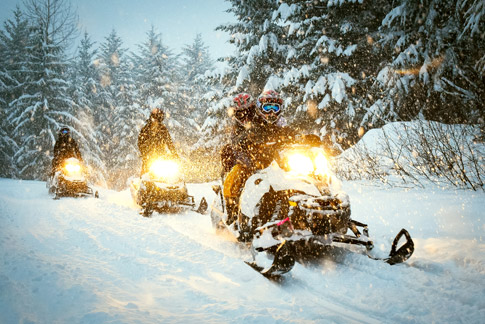7 tips for enjoying snowmobile season

Snowmobiling means adventure and wide open spaces. It’s also a great way of embracing winter and meeting new people. Already dreaming of your next outing? Here are a few tips for enjoying it in perfect safety.
1- Rent before you buy
Whether for half a day or a week, with or without a guide, renting is the best way to test different snowmobile models and find out if you really love the sport. But remember, even though you have to be 16 or over to drive a snowmobile, most rental companies require drivers to be at least 21 years old. The first time you take a snowmobile out, choose one with an engine that’s not too powerful and get some basic training first.
If you decide to buy, think about price, comfort level, performance level, fuel economy, and how and where you plan to use it. And remember that your snowmobile has to be registered, even if you’re only going to use it on snowmobile trails. You also have to get a trail permit.
The 4 key snowmobiling smarts
To ensure you enjoy snowmobiling for many years to come, there are 4 key things to remember: safety, vigilance, caution, and patience. Driving a snowmobile is completely different from driving a car or riding a motorcycle, and it’s not as easy as it looks. The weight transfer in turns and the power of certain models can be surprising. So to make sure everything goes well, it’s strongly recommended that you take a course before you head out for the first time.

2- Wear clothing designed for snowmobiling
It’s never too cold to go snowmobiling if you have the right gear. Prioritize comfort over style, although both are possible.
- DOT certified snowmobile helmet
- Warm, water- and wind-resistant jacket and pants
- Thermal underwear (plus balaclava and warm socks!)
- Boots designed for very cold weather
- Mittens or gloves
Need some extra warmth?
You can pack hand or foot warmers made of active carbon. You can also opt for self-heating gloves, mittens, socks, gaiters, etc., which can come in handy on long trips.
3- Respect the speed limit
The feeling of freedom you get when out on the trail should never make you reckless. Remember that the speed limit on snowmobile trails in Quebec is 70 km/h, and sometimes even lower. Be careful, and comply with the Act respecting off-highway vehicles and the Highway Safety Code (where applicable) to ensure your safety and that of other snowmobilers and road users you may encounter.
Watch out for deer, moose, and other forest animals that could suddenly appear in front of you.
4- Make sure you can get help when you need it
CAA-Quebec is the first automobile association in North America to offer an assistance service to its snowmobiler members. CAA Plus RV and Premier RV members in difficulty can have their snowmobile (or quad) towed up to 160 km if it’s on a roadway that is passable and accessible to tow trucks. This service is offered all year long, but only in Quebec. It counts as one of the four passenger vehicle Roadside Assistance calls to which you are entitled per membership year.
5- Keep your snowmobile well maintained
It’s important to give your snowmobile a tune up before the season starts. Being stranded in the middle of the forest without a cell phone connection carries heavier consequences than having a flat tire in the middle of the city. CAA-Quebec’s Automotive Advisory Services can help you out. Or you can ask a recreational vehicle maintenance and repair shop to inspect your snowmobile (or quad) before you take to the trail.
6- Buy insurance, because you never know what can happen in the forest
Leisure and recreational vehicle insurance (including civil liability) is mandatory if you want to snowmobile in Quebec. If you maintain your coverage all year round, you’ll also be protected against theft and vandalism, even in the summer when the vehicle is in storage.
Remember that Société de l’assurance automobile du Québec (SAAQ) only covers road accidents. It does not cover you if you hit a tree and become disabled. The same goes for bodily injuries to drivers and passengers in trail accidents or those involving only vehicles such as ATVs and snowmobiles.
It’s best to take out insurance for all types of accidents, which will cover you if you are injured (fractures, mutilation, or death) while snowmobiling or engaging in any other recreational activity (hunting, fishing, hiking, etc.). This includes paramedical expenses and compensation for losses incurred.
7- Shop around for your insurance
It’s important to speak directly to an agent rather than applying online, especially if this is your first snowmobile. Make sure you clearly understand the available coverages and protections so you get what you really need. If you engage in more than one motorized recreational activity, you could save by dealing with the same insurer. But whatever you do, get a quote from at least three companies and compare your options!

Benefit from personalized advice
Do you have questions about gas-powered or electric vehicles, driving, or need recommendations to find an Approved Auto Repair Service?